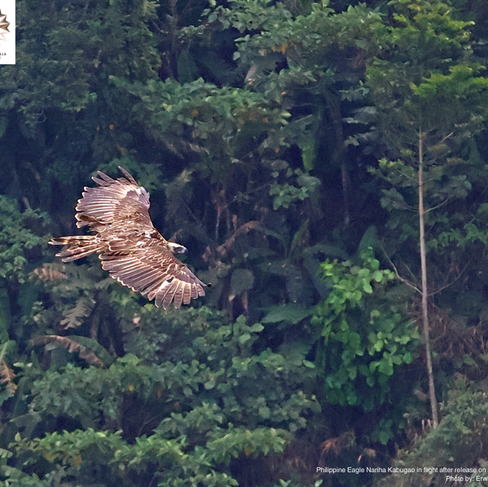by Dr. Jayson Ibañez, PEF Director for Operations

Agadir, Morocco - Philippine eagle and biodiversity conservation efforts by the Provincial Government of Apayao, with the Philippine Eagle Foundation (PEF), Department of Environment and Natural Resources (DENR) and other partners, gained global acclaim after the Province of Apayao - a Philippine eagle and Isnag Biocultural stronghold of the north - was inscribed as one of the newest UNESCO Biosphere Reserve during the 36th International Coordinating Council Meeting of the Man and Biosphere Program (ICC-MAB) held in Agadir, Morocco last July 5, 2024.
The Philippine delegation to the ICC-MAB session in Agadir was headed by Apayao Governor Elias Bulut Jr and Apayao’s Lone District Representative Eleonor Bulut-Begtang, together with PEF Executive Director Dennis Salvador, PEF Director for Operations Dr. Jayson Ibanez, DENR Cordillera Administrative Region (CAR) Regional Executive Director Engr Paquito Morales, and UNESCO Philippines Secretary General Dr. Ivan Henares.

Six years of collective efforts aimed towards this inscription
Called officially as the Biosphere Reserve for the yApayaos, the area covers almost 400,000 hectares of provincial landscapes with 48,254.40 hectares (ha) designated as “core areas” 168,720.54 ha as “buffer zones”, and 178,999.82 ha as transition zones. Isnag is the dominant Indigenous group in Apayao, but there are 10 more ethnolinguistic groups that also call the reserve as home. Collectively, nearly 125,000 residents of Apayao call themselves as the yApayaos.
The approved design of the reserve came after over six years of documentation, biodiversity expeditions, biophysical and cultural mapping, training, awareness campaigns, and international collaborations to fulfill UNESCO requirements.
The aspiration to be a UNESCO Biosphere Reserve began after the first active nest of the IUCN “critically endangered” Philippine eagle in Luzon Island was discovered in Apayao in 2015. This historic documentation of the Philippines’ national bird, and the world’s rarest and most endangered forest eagle, was followed by the detection of more eagle pairs across the old growth forests of the province during succeeding biodiversity expeditions, proving that the lush and ancient forests of Apayao is a stronghold for the majestic Philippine eagle.

Zone Map of the "Biosphere Reserve of the yApayaos"
A shared biocultural heritage
But the eagles also share Apayao’s ancient landscapes with a rich assemblage of unique flora and fauna and the variety of biotic communities and ecosystems they form.
From the highly endemic and endangered Rafflesia manillana, which is the smallest parasitic Rafflesia flower of the country, the Northern Bitatawa, a giant forest lizard that amazingly eat only foliage and fruits - a vegan lizard - and is found nowhere else except only in Apayao and nearby provinces; to the family of tree giants called “Lauan”, which are the country’s tallest and most endangered family of trees.
The traditional yApayao way of life, which is still very much alive, has also inspired the bid for a Biosphere Reserve designation. The late Apayao Governor, Lone District Representative, Calanasan Mayor, and also Isnag Leader and Elder Elias Bulut, for years, popularized and integrated Indigenous customary ways into local government rules.
For example, town rules affirm the observance of Lapat, which is the practice of setting aside portions of forests or rivers as sacred or taboo sites after its Indigenous owner have died.
Lapat areas are off-limits, and trespassers face the curse of sickness, or worst, death from the departed. A lavish say-yam festival lifts the taboo, but only after a few years have passed.
The Lapat practice respects the dead, but the same taboo areas also become temporal sanctuaries for species and ecosystems. Much of the new reserves’ core areas are “lapat” areas of their Isnag ancestral domain owners.
Local government rule also recognizes the ancient “oman” farming technique, or traditional shifting cultivation, as well as the customary roles and authority of village elders during community arbitration for all sorts of conflict.
In the new Biosphere Reserve, these and other yApayao Indigenous knowledge systems are regarded as legitimate bio-cultural conservation institutions that preserve ancient practice and places of spiritual and ecological renewal.
“This…marks another milestone not only for our beloved province, but also for our country (the) Philippines”, said Apayao Governor Bulut in his acceptance speech in front of the nearly 300 ICC-MAB members and delegates in Agadir.
“We hope to inspire other learning spaces for conservation and sustainable development in the Philippines and around the world … (and) together we strive with our shared mission and responsibility to save what is left of our natural resources…and globally endangered species like the majestic Philippine eagle from extinction”, he added.

Mother eagle feeding her one month old chick on the eagle nest at Apayao. Photo by: Tatiana Rose Abaño-Sarigumba
Apayao is part of the 11 newest UNESCO Biosphere Reserve in the world, and is the fourth in the Philippines, joining Albay, Palawan and Puerto Gallera.
Its network of collaborators includes the US Forest Service, San Roque Power Corporation and the Forest Foundation Philippines.
--
RELATED: More of how we discovered the nest in Apayao (read the full paper): https://tinyurl.com/ynvcdrfd









Comentarios